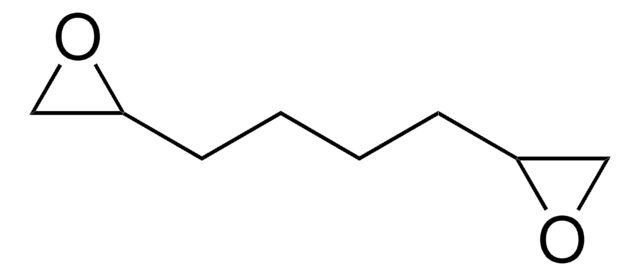338036
Neopentyl glycol diglycidyl ether
technical grade
Synonym(s):
1,3-Bis(2,3-epoxypropoxy)-2,2-dimethylpropane, 2,2′-[(2,2-Dimethyl-1,3-propanediyl)bis(oxymethylene)]bis[oxirane]
About This Item
Recommended Products
grade
technical grade
vapor density
>1 (vs air)
form
liquid
eq. wt.
135-165 g (epoxide)
refractive index
n20/D 1.457 (lit.)
viscosity
10-30 mPa.s(25 °C)
bp
103-107 °C/1 mmHg (lit.)
density
1.04 g/mL at 25 °C (lit.)
SMILES string
CC(C)(COCC1CO1)COCC2CO2
InChI
1S/C11H20O4/c1-11(2,7-12-3-9-5-14-9)8-13-4-10-6-15-10/h9-10H,3-8H2,1-2H3
InChI key
KUAUJXBLDYVELT-UHFFFAOYSA-N
Related Categories
General description
Application
- As a cross-linking agent to prepare Pullulan/polydopamine hydrogels for selective adsorption of pollutant cationic dyes.
- As a monomer to synthesize gel polymer electrolytes for Li-ion batteries via cationic ring-open polymerization.
- As a precursor for the synthesis of hybrid epoxy methacrylate resins cationic and free-radical photopolymerization. These epoxy resins can be used as anti-corrosion and decorative coatings.
- To synthesize epoxy nanocomposites for fabrication of light-emitting devices.
Signal Word
Warning
Hazard Statements
Precautionary Statements
Hazard Classifications
Skin Irrit. 2 - Skin Sens. 1
Storage Class Code
10 - Combustible liquids
WGK
WGK 1
Flash Point(F)
235.4 °F - closed cup
Flash Point(C)
113 °C - closed cup
Personal Protective Equipment
Certificates of Analysis (COA)
Search for Certificates of Analysis (COA) by entering the products Lot/Batch Number. Lot and Batch Numbers can be found on a product’s label following the words ‘Lot’ or ‘Batch’.
Already Own This Product?
Find documentation for the products that you have recently purchased in the Document Library.
Customers Also Viewed
Our team of scientists has experience in all areas of research including Life Science, Material Science, Chemical Synthesis, Chromatography, Analytical and many others.
Contact Technical Service









![Bis[4-(glycidyloxy)phenyl]methane mixture of isomers](/deepweb/assets/sigmaaldrich/product/structures/915/436/edb8eab6-834e-4238-a904-bf72c573b686/640/edb8eab6-834e-4238-a904-bf72c573b686.png)
